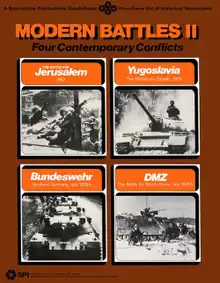
Modern Battles II: Four Contemporary Conflicts is a collection of four board wargames published by Simulations Publications, Inc. (SPI) in 1977 that simulates three hypothetical contemporary battles as well as the battle for Jerusalem during the Six Day War in 1967. This collection was a sequel to SPI's popular Modern Battles published two years before.
Description
Modern Battles II is a "quadrigame" — a box containing four thematically linked games that use the same rules. One of the games, designed by Mark Herman, focuses on the battle for Jerusalem that occurred only ten years before, during the Six Days War. The other three are hypothetical battles that could result from a situation current in 1977 that could turn "hot":[1]
- Bundeswehr: Combat in West Germany following a hypothetical invasion by Warsaw Pact forces. (Designed by Virginia Mulholland)
- DMZ: A hypothetical renewal of Korean War hostilities. (Designed by Joe Balkoski)
- Yugoslavia: The fight for the city of Zagreb during a hypothetical invasion of Yugoslavia by Warsaw Pact forces. (Designed by Phil Kosnett)[2]
Gameplay
With a small 17" x 22" hex grid map and 200 counters for each game, these games have been characterized as "basically simple".[3] Each turn, which represents 12 hours of game time, consists of five phases:
- Special Weapons Fire (both players)
- First Player Movement
- First Player Combat
- Second Player Movement
- Second Player Combat
The three hypothetical games (Bundeswehr, DMZ, and Yugoslavia) borrow the "untried unit" rule from SPI's Panzergruppe Guderian wargame: Units of each type are shuffled and placed in starting positions upside down so that neither player is aware of their combat strengths. When each unit is engaged in combat for the first time, the unit counter is flipped right side up to display its actual combat strength.[3]
In addition to the common rules used by all four games, each game also has a few unique rules that are germane to its situation: special terrain, specialized units, city combat, command problems, and even nuclear weapons.[3]
Publication history
SPI published their first "quadrigame", Blue and Gray, a set of four American Civil War battles, in 1975. The format proved very popular, and SPI quickly produced more quadrigames, the next being Modern Battles, which also proved to be a popular product.[1]
In 1977, SPI released a sequel to Modern Battles titled Modern Battles II, with four games featuring four new game designers[4] with graphic design by Redmond A. Simonsen. The sequel also proved to be popular, rising as high as #4 on SPI's Top Ten Bestseller List.[5]
The four games in the collection were also released as individual games, packaged as "folio games" (games enclosed in a cardstock double LP-type folder.)
Reception
In Craft, Model, and Hobby Industry Magazine, Rick Mataka noted the quality of the components, calling them "professionally produced", and emphasized the contemporary nature of the games, saying, "Each simulation deals with some future conflict that could occur."[6]
In The Guide to Simulations/Games for Education and Training, Martin Campion noted the simplicity of the game rules, except for the artillery rules that "tend to put a larger strain than usual on players' abilities to add numerous numbers in their heads and to consider several alternatives at the same time."[3]
In the 1980 book The Complete Book of Wargames, game designer Jon Freeman commented in the introduction of the book that "a game based on a battle that never took place has two major attractions for nonhistorians. First, you are not playing in the shadow of Napoleon or Rommel. [...] Second, you do not have the original tactics and strategies to fall back on: you must be innovative." Freeman thought these were the reasons that Modern Battles II was so popular, also noting "the element of speculation is quite limited: [...] the data for such potential conflicts are available today."[7]
In Issue 13 of Jagdpanther, John Herlocker noted "The Modern Battles system, while excellent for conventional warfare, falls flat when it comes to nuclear weapons." Herlocker went on to suggest a system for the use of nuclear weapons, including rules for firestorms and fallout.[8]
Other reviews and commentary
- Moves #55[9]
- Fire & Movement #9 & #13
- The Wargamer Vol.1 #13
References
- 1 2 Palmer, Nicholas (1977). The Comprehensive Guide to Board Wargaming. London: Sphere Books. p. 161.
- ↑ Vandenbroucke, Dav; Kritzer, Art; Train, Brian (April 2004). "Modern Battles II". Simulacrum. No. 20. pp. 63–66.
- 1 2 3 4 Campion, Martin (1980). "Modern Battles II". In Horn, Robert E.; Cleaves, Ann (eds.). The Guide to Simulations/Games for Education and Training. Beverly Hills CA: Sage Publications. pp. 502–503. ISBN 0-8039-1375-3.
- ↑ Kosnett, Phil (November–December 1977). "Modern Battles II". Fire & Movementissue=7.
- ↑ "SPI Best Selling Games - 1977". spigames.net. Retrieved 2022-12-17.
- ↑ Mataka, Rick (September 1977). "Boardgaming Showcase". Craft, Model, and Hobby Industry Magazine. p. 94.
- ↑ Freeman, Jon (1980). The Complete Book of Wargames. New York: Simon & Schuster. pp. 34–35.
- ↑ Herlocker, John (September 1978). "Modern Battles II: The Nuclear Variant". Fire & Movement.
- ↑ https://strategyandtacticspress.com/library-files/Moves%20Issue55.pdf